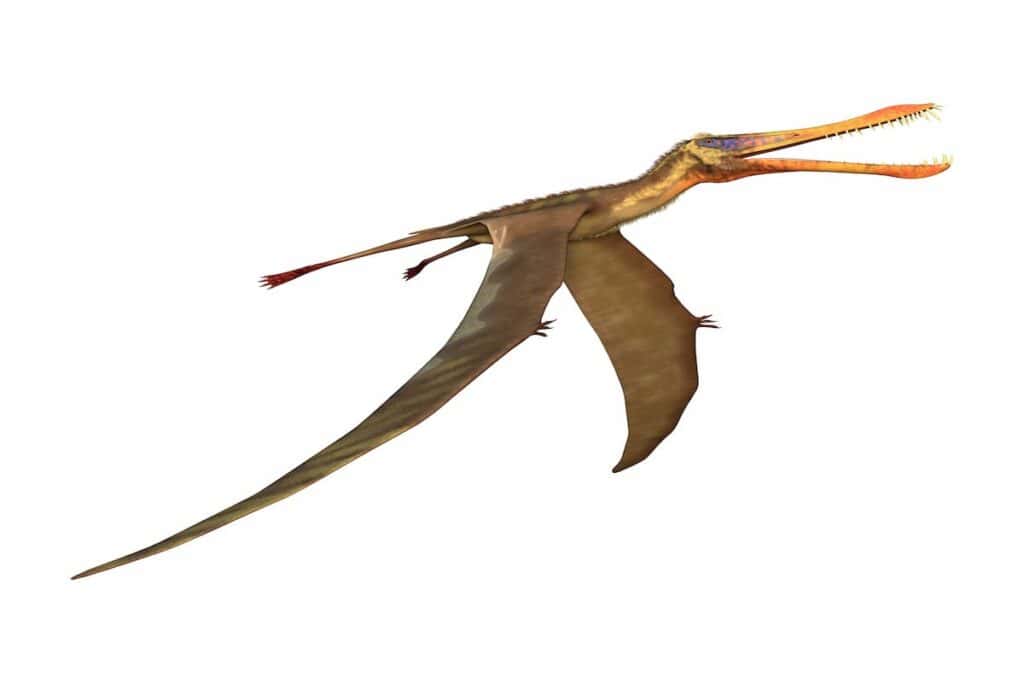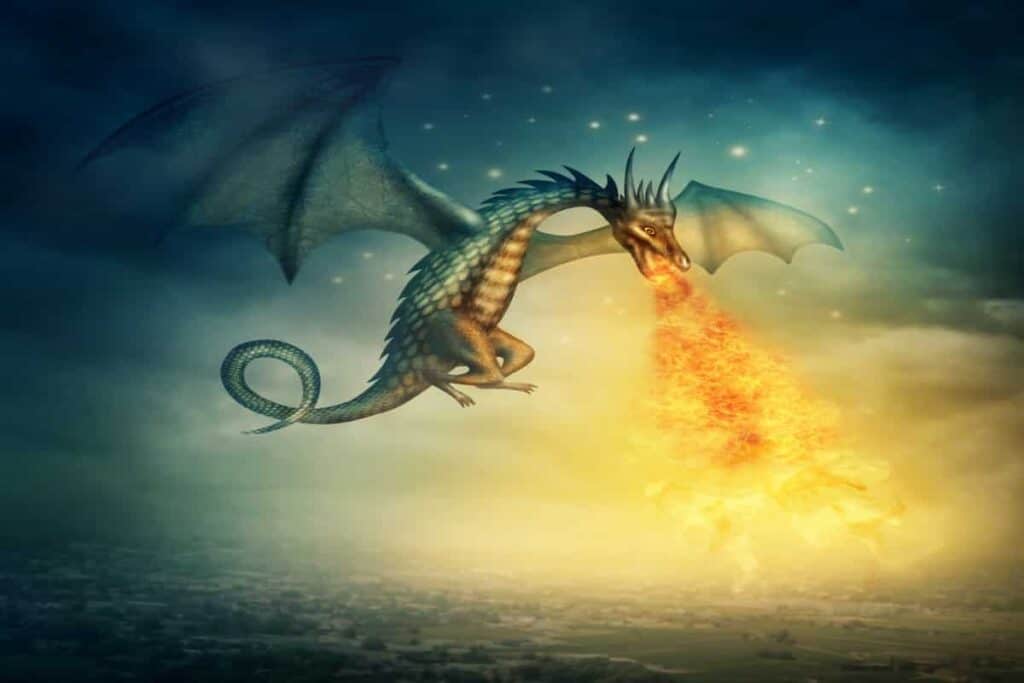Dinosaurs and dragons are very mystical creatures. They are featured in many movies, and much research has been conducted to seek the presence of these organisms. It has been noted that dinosaurs are real with fossil evidence, but dragons remain as fiction. One surprising fact is that there are flying dinosaurs, and this is where a possible question may arise if these flying dinosaurs are dragons.
Are flying dinosaurs dragons? There are no flying dinosaurs, but rather flying reptiles is a more accurate term. Dragons are mythical creatures. Pterodactyls are not dragons. Dinosaurs and flying pterosaurs are only closely related because they are distant cousins under Archosauria.
When we talk about flying dinosaurs, the top on the list is Pterodactyl, but you should be careful since pterodactyls are not even dinosaurs.
For some, they appear as dragons or dinosaurs, but actually, they are ancient flying reptiles. The flying ability can be confused with other flying dinosaurs and dragons, but they specifically belong to a distinct group called Pterosaurs.
This article compiles some facts to compare the famous flying reptile, Pterodactyl, to dragons. Also, information on what dinosaurs are closely related to dragons.
Pterodactyl Classification and Anatomy
An easy way to trace the relatedness of one species to another is to check its anatomy and classification. Here are some facts for pterodactyl phylogeny useful for us to delineate it from dinosaurs or dragons.
Pterodactyl Anatomy: Some of Its Key Features For Identification
Pterosaurs were carnivorous, and they feed on fish and other small animals. The anatomy of this reptile is modified from their reptilian ancestors by their adaptation to flight. Pterosaurs‘ bones were a little hollow and air-filled like birds. They have keeled and large breast bones for flight muscles and a very enlarged brain which helps them coordinate complex flying behavior.

Pterodactyls skeletons often show considerable fusion. In the skull, the sutures between their elements disappeared. In some, later on, pterodactyls/pterosaurs’ backbone is over their shoulders, and they fuse into a structure now called a notarium which helps stiffen their torso and gives them stable support during flight.
These sacral vertebrae can also form a single synsacrum, and their pelvic bones are also fused. Compared to other flying vertebrae groups (birds and bats), pterosaurs‘ skulls were quite large. Most of their skulls had elongated jaws. Pterosaurs had heterodont teeth, and later on, their teeth became conical. These creatures are defined by their elaborate head crest of well-known Pteranodon.
Its central position in the front of the snout is an outgrowth of the premaxilla, the rear of the skull as the extension of their parietal bones called supraoccipital crest. They were completely composed of keratin which means they don’t fossilize easily. It misled some researchers and scientists.
Pterodactyls’ extent was discovered only through ultraviolet photography, while fossil crests used to be restricted for more advanced Pterodactyloidea. Their upper and lower jaws were very elongated. (Source)
Often, it is compared or confused to flying dinosaurs, but it is time to debunk the term flying dinosaurs because there is no such thing. These flying dinosaur descendants are possibly birds-like as Archeopteryx.
Pterosaur Classification and Phylogeny
These flying dinosaurs are also not dragons; however, their wings and other traits would tell people who they are, so they are also mistaken as dragons. Dragons are imaginary creatures written about in literature and historical texts and vary across various cultures in Europe, China, and the Middle East.
Pterodactyls or commonly known as pterosaurs, are an extinct group of winged reptiles. These reptiles lived from the Triassic Period up until the end of the Cretaceous period. They were mistaken as dinosaurs since they almost live simultaneously, but they are different branches of a big tree. Dinosaurs were only restricted to land and some aquatic habitats. (Source)
They were extinct along with dinosaurs. Pterosaurs are intriguing because they were the first vertebrae or vertebrates to master flight; they soar high above their cousins on the ground. Some of these pterosaurs existed 66 million years ago, but some date to about 250 million years ago.
This group of reptiles belongs to the taxonomic order Pterosauria while dinosaurs are divided into three major groups, and Pterosaurs are not one. To date, what makes them related is belonging to the same umbrella group called Archosaurs together with crocodiles and dinosaurs.
The article you are reading is one of the 11 Series Articles connected to the Flying Dinosaur Types – Ultimate Guide to Pterodactyls, Pterosaurs. Check out the Ultimate Guide (see description and link directly below) or other key Series Articles selected for you at the bottom of this article!
Flying Dinosaur Types – Ultimate Guide to Pterodactyls, Pterosaurs
Main Article – With Links to 11 Series Articles
❖ Read Now! Flying Dinosaur Types – Ultimate Guide to Pterodactyls, Pterosaurs
This is the main article in the series and it is packed with information all about the flying reptiles that ruled the skies during the Mesozoic Era. It covers the different types of pterosaurs, from the basal pterosaurs and later species as well. There are sections on pterodactyl anatomy, classification, and phylogeny. The master article also covers:
—Interesting facts you may not know about pterosaurs
—Tables comparing wingspan sizes of different pterosaur species
—Links to all the Series Articles (11 in total!) which give deeper information about the pterosaurs
Dragon Similarities Based on Mythical Dragon Descriptions
Dragons are very magical. They are often famous characters in childhood stories and even the animated movies of today. A pterodactyl, a flying reptile, could have similarities with dragons based on mythical descriptions, and here are some.
The Magical Myths of Dragon Existence
Dragons are the most popular and most enduring mythological creatures in the world. They have a rich history with these creatures. Dragon myths were known in many cultures like Europe and the Americas, China, and India.
A dragon is a large legendary serpentine creature that mostly appeared in the folklore of many cultures worldwide. The beliefs on dragons vary from religion to religion. In Western cultures in the middle age, Dragons were described as horned, winged, four-legged, and capable of breathing fire. (Source)
At the same time, dragons in the eastern cultures are described as wingless, four-legged with above-average intelligence serpentine creatures. They resemble giant snakes. This myth has been passed on from one religious culture and generation to the other.
Over many years, we were told to believe that they truly exist. However, if they may be true, they may have had closer relation to the Triassic period. Though no evidence exists to prove this case; however, during the Triassic period, Pterodactyls existed, and since known, they’ve been often mistaken as Flying Dinosaurs or Dragons, of which they are both not.

People in the medieval period often believe that dragons are harbingers of good fortune and wealth. During that period, the rest of the world believed that they are keepers of rivers, lakes, and caves.
Migrating crocodiles (which are now extinct) are their actual closest resemblance. Some would also say that these mythological fire-breathing creatures represent an evil fortress and darkness, and some would also say they are guardians, just like in the movie Mulan.
It was concluded that dragons appear in almost all cultures because humans have an innate fear of snakes and were subjected to as the greatest predators of humans. It has been said that these serpents reside in deep pools, dank caves, wild mountain reaches, sea bottoms, and haunted forests.
Unlike dragons, dinosaurs existed about 66 million years ago and went extinct during the Cretaceous period. According to literature and historical books, European dragons have massive winged beasts, and Asian dragons are more like snakes with legs. Flying Dinosaurs are not dragons; however, they have similar characteristics, making most people think they are just the same.
Dragons came from the discovery of giant fossils, and it may be that people before discovered fossil remains and mistaken the remains for dragon remains even when they’re not. This dragon hoax was loosely based on recently extinct reptiles such as; pterodactyls.
In China, they call dragons long. Not many paleontologists believe that dragon legends were just invented by ancient people and civilizations who could take a glimpse of living and breathing fire dragons or dinosaurs and have been passed down to generations.
Moreover, this did not stop our paleontologist from playing around with and having fun with this Dragon Myth. Dragons may not exist, but they can still be represented, at least in a dinosaur form. It would explain the recent dinosaurs Dracorex and Dracopelta and Dilong and Guanlong.
Commonalities and Differences Between Dragons and The Flying Pterodactyl
Similarities between dragons and the mistakenly flying dinosaur under pterosaurs often hybrid avian, feline, and reptilian features. It includes four legs, a reptilian scaly skin tail, spinal running nodes that run down their back, and a serrated jaw with rows of teeth.
A pterodactyl is the closest thing we have to a dragon. The major factor that tends to compare the two is that both can fly, and flight is one reason to succeed in the trophic levels.
With the ability to fly, they can feed both on land, aquatic and aerial, which means they can be the top predators, especially in aerial habitats.
Even though pterodactyls are close to dragons, they are also different since dragons, according to myth, can spit out fire, which the flying pterosaurs cannot do. This fire-breathing dragon used this as a defense against possible enemies or to hunt prey.
What Dinosaur or Flying Reptile is Closest to a Dragon?
If you might still wonder what the closest organism to a dragon is, then here are the best two you might consider. It is based on their similar morphology, habit, and ability to fly.
Pterodactyls: The Closest We Can Get
Flying reptiles closest to dragons are pterodactyls. They have the same characteristics, and pterodactyls don’t breathe fire like most dragons described in myths. Seemingly the mythology about these dinosaurs came from the interpretation of how once-living winged prehistoric reptiles may have looked when they were alive from their fossil remains. (Source)
In the past and up until today, we humans can only speculate what a living dinosaur may have looked like comparing this to the animals living today. The discovery of fossils of winged animals/ creatures may have encouraged many to believe in dragons. Their imagination of such a beast has led it to be passed on from one generation to the other.
Flying dinosaurs are birds and not pterosaurs. Let’s be clear on that. Dragons are still not likely, especially in medieval times, didn’t always really resemble lifeforms, unlike pterosaurs. The word dragon means serpent in Greek, which is snake-like. The earliest mythological dragons, as mentioned above, resemble snakes more than they do with dinosaurs and reptiles Pterodactyl.
Draco: The Modern Flying Dragon
Draco is a genus of flying lizards. They are existing today and can fly via extended membranes forming wings called a patagium. They do not spit fire and consume only aerial insects. Their body, like other reptiles, is scaly with a long and slender tail.
This lizard measures only around eight inches but can glide at around 200 feet, which is quite a distance for its size. They are common in forests, teak plantations, and shrub jungles. Their display structure or the patagium is efficient for gliding and lift. (Source)
Conclusion
Myths and fascinating creatures like dragons and dinosaurs are often shared in many books and movies. Maybe at some point, we have believed that some of these creatures truly existed until factual evidence surpassed and was able to clarify everything. The Triassic to Cretaceous period was when pterodactyls existed to which they were mistaken to be dragons or flying dinosaurs. There you have it, flying dinosaurs and dragons did not exist, but only the ancient flying reptile Pterodactyl did. Until further discoveries and explanations on these creatures can prove otherwise, this is what we have.

